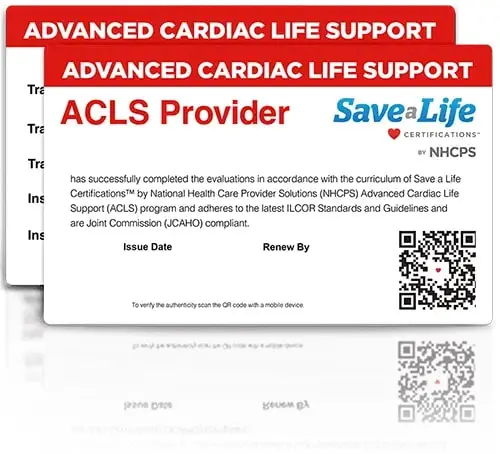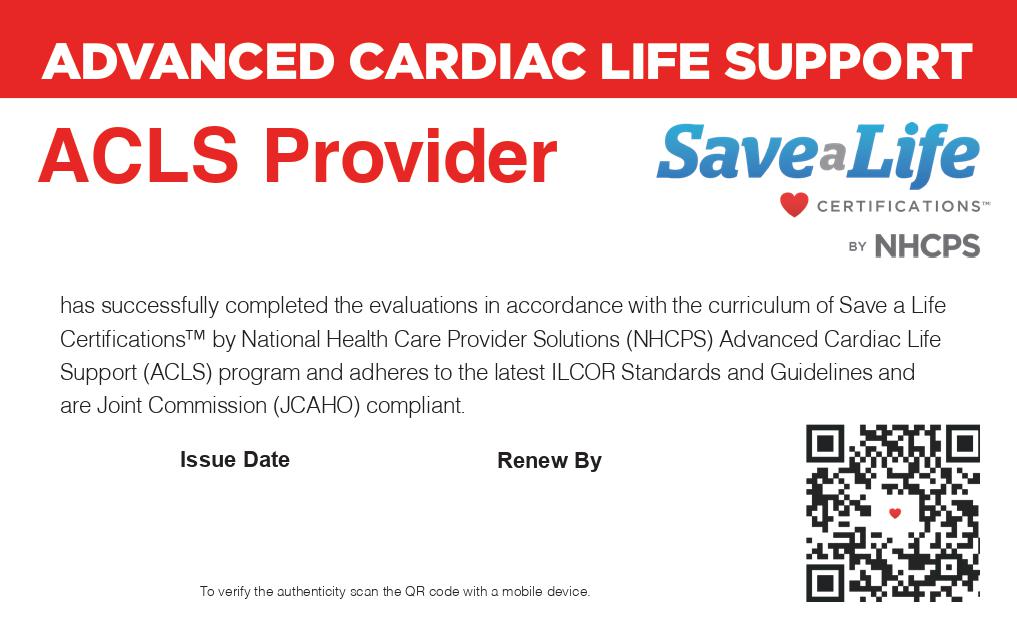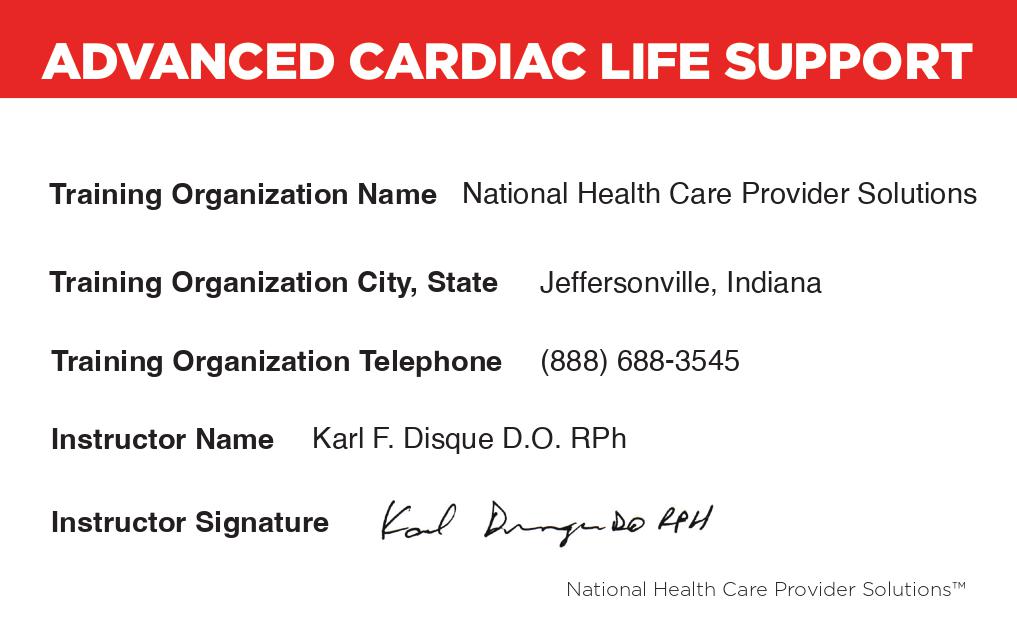Your cart is currently empty!

Get BLS FREE with ACLS and PALS.

Pay Once. Recertify Forever.
Purchase a For Life Course from us once, and you will never have to pay for certification again. Just log in, pass the exam and download your digital provider card. Come back in two years and repeat. This can save you up to $1,500 over the course of your career!
Learn More
7917587
Lifesavers empowered
EMPOWERED BY THE
a non-profit organization
187
Countries and territories served

Our ACLS, PALS & BLS Courses are accredited by the Post Graduate Institute for Medicine, offering Category 1 CEU credits. Therefore these certifications are also Joint Commission compliant.
For your security and peace of mind, all of our courses include a hassle-free refund policy.
If you are unhappy with our course for any reason, our Empowerment Team will refund your purchase.
Introduction
Basic Life Support
Advanced Cardiac Life Support
Principles of Early Defibrillation
Systems of Care
ACLS Cases
Introduction To ACLS – Get a glimpse of the Advanced Cardiovascular Life Support course. Familiarize yourself with the elements of the course, including course goals.
First Assessment– Know what to do in case of an emergency. Determine whether you should begin with BLS or ACLS in an emergency situation.
2020 BLS Guideline Changes – Update yourself on the 2020-2025 BLS changes recommended by the International Liaison Committee on Resuscitation. Compare and contrast a list of previous and current recommendations.
ACLS BLS For Adults – Introduce yourself to the adult BLS procedure: chest compressions, establishing airway, giving breaths, and using AED for defibrillation. Also, learn the difference between CPR with one rescuer and CPR with two rescuers.
General Concepts Of BLS – Familiarize yourself with an overview of the Basic Life Support. Further, learn about the Chains of Survival for adult and pediatric care.
One Rescuer Adult BLS CPR – Learn how to perform adult BLS and CPR as a lone rescuer. Use the provided diagrams to thoroughly engage yourself in the step-by-step CPR process.
Two Rescuer Adult BLS CPR – Learn how to perform adult BLS and CPR as part of a two-rescuer team.
Adult Mouth To Mask Ventilation – Learn steps to perform mouth-to-mask ventilation as a lone rescuer.
Normal Heart Anatomy & Physiology – Dive into the anatomy and physiology of the heart. Take a journey through the electrical pathways of the heart, including the blood’s way through the atria, ventricles, and other cardiac parts.
The ACLS Survey (A-B-C-D) – Learn about the steps to take during the ACLS survey, which includes Airway, Breathing, Circulation, and Differential Diagnosis (ABCD).
Airway Management – Learn about airway management and techniques. Familiarize yourself with inserting basic airway adjuncts and the knowledge of advanced airways and its equipment.
Basic Airway Adjncts – Become an expert in the use of basic airways: oropharyngeal airway (OPA), nasopharyngeal airway (NPA), and suctioning.
Basic Airway Technique – Learn step-by-step procedure to insert oropharyngeal and nasopharyngeal airways as well as get tips on suctioning.
Advanced Airway Adjuncts – Become an expert in the use of advanced airways: endotracheal tube (ET), laryngeal mask airway (LMA), laryngeal tube, and esophageal-tracheal tube (Combitube).
Routes of Access – Learn about the two priority vascular routes: intravenous (IV) and intraosseous (IO).
Pharmacological Tools – Refresh your memory on ACLS medication. Review the provided table to reference information about adult drug dosage, routes, and uses of common drugs.
Principals of Early Defibrillation – Get a glimpse of defibrillation and AED. Learn about the purpose of defibrillation, principles of early defibrillation, basic AED operations, and delivering shock.
Key to Using Automated External Defibrillator (AED) – Learn in detail on the use of the AED, including the criteria to apply AED and step-by-step procedure to operate an AED.
Systems of Care – Introduce yourself to the Systems of Care based on the ILCOR guidelines. Systems of care describe an organization of professionals necessary to respond during emergencies and in any given circumstances.
Cardiopulmonary Resuscitation – Get to know the steps of the adult CPR Chain of Survival.
Post Cardiac Arrest Care– Learn about the interventions for post-cardiac arrest care: therapeutic hypothermia, optimization of hemodynamics and ventilation, percutaneous coronary intervention, glucose control, and neurological care.
Acute Coronary Syndrome – As a health care provider, learn to recognize individuals with potential ACS. Get your hands on the STEMI Chain of Survival and further learn the goals of ACS treatment.
Acute Stroke– Get your hands on the Stroke Chain of Survival. Further, learn about the goals of Acute Ischemic Stroke Care (the 8 D’s).
The Resuscitation Team – Whether you are a team leader or a team member, team dynamics during resuscitation are vital. Learn about what you can bring to the table as a leader or as a member of the resuscitation.
Education, Implementation, Teams – Introduce yourself to the concepts of Rapid Response Team (RRT) and Medical Emergency Team (MET). Get familiar with tasks to do as a nurse, physician, or even a family member during the event of a cardiac arrest.
Respiratory Arrest – Know what to do during a respiratory arrest, whether it is the ACLS or the BLS steps that you are performing. Further, get to know the types of ventilation (advanced and basic) and the techniques of placing the airways.
Ventricular Fibrillation & Pulseless Ventricular Tachycardia – Study the rules for ventricular fibrillation (VF), ventricular tachycardia (VT), and torsades de pointes. These rules include guidelines for regularity, rate, waves, intervals, and complexes for all three cases.
Pulseless Electrical Activity (PEA) & Asystole – Study the rules for pulseless electrical activity (PEA) and asystole. Learn about the reversible causes of PEA (the H’s and the T’s).
Adult Cardiac Arrest Algorithm – Use the infographic to gain knowledge about the steps to take in case of an adult cardiac arrest. Further, learn how about the quality of CPR you give, shock energy, return of spontaneous circulation (ROSC), advanced airway, drug therapy, and reversible causes of cardiac arrest.
Post-Cardiac Arrest Care – Get a glimpse of what to do after a cardiac arrest has passed: optimize ventilation and circulation; preserve heart and brain tissue and function; and maintain recommended blood glucose levels. Learn how blood pressure support, vasopressors, and hypothermia help during post-cardiac arrest care.
Adult Immediate Post-Cardiac Arrest Care Algorithm – Acquaint yourself with immediate post-cardiac arrest care elements, including ventilation and oxygenation, doses and its details, reversible causes of cardiac arrest, and steps to take in case of return of spontaneous circulation (ROSC).
Symptomatic Bradycardia – Study the rules for sinus bradycardia, first degree AV block, second degree type I AV block (wenkebach), second degree type II AV block (mobitz II), and third degree AV block (complete heart block). These rules include guidelines for regularity, rate, waves, intervals, and complexes for all cases. Further, also get a glimpse of symptoms of bradycardia.
Adult Bradycardia with Pulse Algorithm – Use the infographic to gain knowledge about the steps to take in case of an adult bradycardia with pulse. Also, learn about the symptoms of tachycardia, and what to do in the event of tachycardia pulse being higher than 100 BMP symptomatic.
Stable & Unstable Tachycardia – Study the rules for sinus tachycardia, atrial flutter, and atrial fibrillation (A-FIB). These rules include guidelines for regularity, rate, waves, intervals and complexes for all cases. Also, learn about the symptoms of tachycardia, and what to do in the event of tachycardia pulse being higher than 100 BMP symptomatic.
Adult Tachycardia with Pulse Algorithm – Use the infographic to learn what to do in case of an adult tachycardia with pulse. Also get a quick glimpse of dosages for adult tachycardia with pulse.
Acute Coronary Syndrome – Learn about ACS and its symptoms; and get a glimpse of the EMS pathway.
Acute Coronary Syndrome Algorithm – Use the infographic to learn what to do when rescuing someone with ACS.
Acute Stroke – Learn about Acute Stroke and its symptoms; and get a glimpse of the EMS pathway. Further, review the goals set by National Institute of Neurological Disorders and Stroke (NINDS) for situations when the time of symptom onset is known.
Acute Stroke Algorithm – Use the infographic to learn what to do when rescuing someone suffering from Acute Stroke.
Digital/Printed ACLS Provider Card


| Feature | Certification | Recertification |
|---|---|---|
| Access any time, anywhere | ||
| Instant feedback | ||
| Instant proof of certification | ||
| Required clinical skills test | ||
| ACLS PDF Provider Handbook included | ||
| Unlimited retakes | ||
| Save progress so you can stop and continue at a later time | ||
| Timed examination | ||
| Available on mobile/tablet platforms | ||
Continuing medical education (CME) Eligible for up to 8 AMA Category 1 Credits™ | Up to 8 Credits | Up to 4 Credits |
Complete your ACLS course 100% online with Save a Life Certifications! All of our courses are designed by Board Certified Physicians and adhere to the latest ILCOR Standards and Guidelines and are Joint Commission (JCAHO) compliant. In addition, all of our courses meet the same guidelines and standards as the ECC/ILCOR, and OSHA.
Our course and training materials were constructed in accordance with the latest ILCOR Standards and Guidelines and are Joint Commission (JCAHO) compliant. Save a Life Certifications’ on-staff physicians regularly review and compare all course tests and materials, updating them as needed with any changes published by ILCOR to ensure that the certification training class you receive is always up to date!
Is your organization accredited by AHA?
This is a common misconception. The AHA is not an accrediting body. We are accredited by the Postgraduate Institute for Medicine (PIM). All courses are designed by practicing physicians, meeting the same guidelines and standards as the latest ILCOR guidelines.
Can I complete my ACLS course online?
The short answer — absolutely!
Our courses are made to fit the demands of your busy professional life. Many healthcare professionals are new to the concept of an online certification course because until recently, online certification was not an option. Our course adheres to the latest ILCOR Standards and Guidelines and are Joint Commission (JCAHO) compliant. Save a Life Certifications has a national acceptance rate of more than 98%.
If your employer does not recognize your Save a Life certification, or you are unhappy for ANY reason, we offer a 100% money-back guarantee.
How do I receive my ACLS Certification Provider Card?
After you successfully complete your ACLS course, you will receive a printable digital provider card instantly, to serve as proof of certification.
Your provider card will display your name, the Save a Life Certifications logo, course completion date, expiration date, our course provider number, and validating signature.
Fast, 100% online ACLS training and certification provide you the freedom to complete your course from anywhere at any time!
Save a Life Certifications allows healthcare professionals to meet their continuing education requirements without sacrificing their limited time to attend a weekend certification or recertification course. Save a Life Certifications provides convenient, flexible, accessible life support education programs.
We lead the industry in online certification by providing the most updated, accepted, and convenient certifications available.
Advanced Cardiac Life Support (ACLS) Provider Handbook in PDF format is included, training is entirely online, and no clinical skills test is required.
Included with your course is our Provider Handbook in PDF format for fast, convenient study anywhere. You are able to access your course material at any time, from your internet-connected computer, smartphone, or tablet, through your Save a Life Certifications account. If you prefer to have a physical copy with you, you are able to save and print your manual as well. No in-person skills test is required, and all training materials are included with our course.
Exam review and proof of certification are available immediately after passing.
Immediately after you complete our Advanced Cardiac Life Support (ACLS) final exam, your results are calculated, displayed in your account, and emailed to you. A digital provider card is immediately available to download and print to provide proof of certification. Your provider card will display your name, the Save a Life Certifications logo, course completion date, expiration date, our course provider number, and validating signature.
Continuing Medical Education (CME) credits.
Our Advanced Cardiac Life Support (ACLS) courses are eligible for AMA Category 1 Credits™. The Postgraduate Institute of Medicine (PIM), an accredited provider, has reviewed Save a Life Certifications’ Advanced Cardiac Life Support (ACLS) Certification Course and Advanced Cardiac Life Support (ACLS) Recertification Courses. The ACLS Certification training course has been approved for AMA Category 1 Credits™.
Unlimited exam retakes at no additional cost.
You are not penalized if you do not successfully pass your certification exam on your first attempt. Your results are available in your account indefinitely for your review, and an exam recap is sent to your email address. Take all the time you need to review the study materials in your account, and compare your responses to the provider handbook. When you’re ready, you may retake the exam at no additional cost.
What occupations typically need ACLS?
Your satisfaction is assured, backed by a 100% money-back guarantee.
For your security and peace of mind, all of our courses include a 100% money-back guarantee. If you are unhappy with our course for any reason, you can contact us for a full refund of your purchase (minus any shipping and material fees).